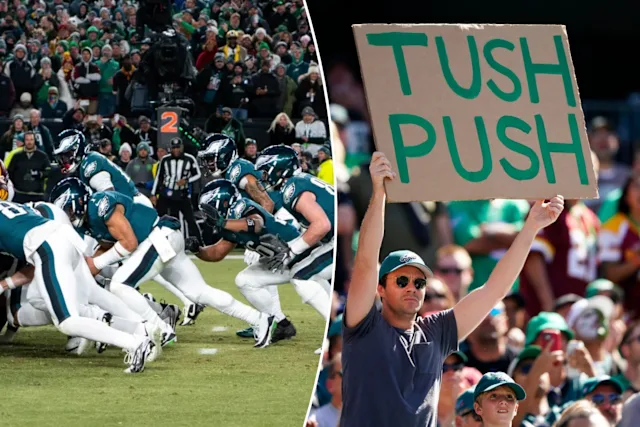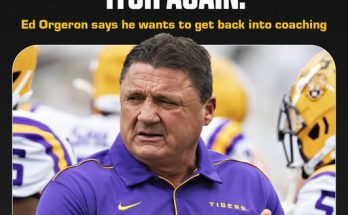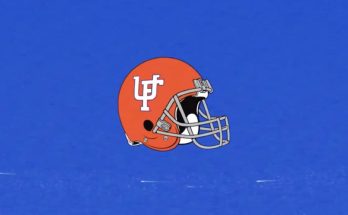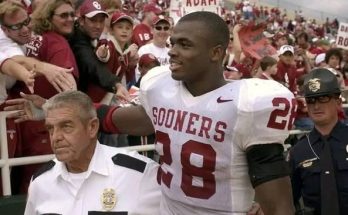The “tush push” – also known as a quarterback sneak, often executed with assistance from teammates – has become one of the most polarizing plays in the NFL. Popularized by the Philadelphia Eagles, this play has raised concerns from multiple angles, especially regarding player safety and fairness in the competitive landscape of the league.
The play involves the quarterback sneaking the ball forward while being pushed from behind by offensive linemen and sometimes even other players. The Eagles, under head coach Nick Sirianni, have deployed it to great success in short-yardage situations, particularly on fourth downs. It has proven highly effective, allowing teams to gain crucial yards and convert difficult situations into first downs.
However, as the play’s success has grown, so too has the conversation surrounding its fairness and potential safety risks, leading to proposals to ban the maneuver entirely.
2. A Historical Perspective on the Tush Push
The “tush push” is not a new concept in football. The idea of pushing the quarterback forward during a sneak has been around for decades, but it gained attention due to the Eagles’ exceptional execution of it, especially during their 2022-2023 season when they utilized it with remarkable success.
In its most effective form, the Eagles had their quarterback, Jalen Hurts, at the center of the play. The combination of Hurts’ strength and the forceful support of his offensive line allowed them to gain consistently significant yards. Hurts, often referred to as one of the NFL’s toughest quarterbacks, was able to push through the defensive line with minimal resistance, aided by teammates behind him.
The success of the “tush push” brought the play to the forefront of NFL strategy debates. While it was initially viewed as a simple and effective tool, its increasing use highlighted some weaknesses in the NFL’s existing rules and raised questions about player safety and competitive fairness.
3. The Proposal to Ban the Tush Push
The Green Bay Packers submitted a formal proposal to the NFL to ban the “tush push” at the league’s annual meetings in early 2025. This proposal, if accepted, would aim to remove the quarterback sneak with assistive pushing from the playbook entirely. The reasoning behind this motion stems from both strategic concerns and safety issues, with teams like the Packers struggling to defend against it.
This proposal is not unique to the Packers. Several other teams within the league have echoed similar concerns. Although some owners and coaches view it as a strategic advantage that is within the bounds of the game’s rules, the increasing effectiveness of the play and the perceived unfair advantage it gives the Eagles has led to more calls for its regulation.
16 NFL owners supported the proposal at the league meeting, but it was not enough to meet the required supermajority of 24 votes needed to pass the rule change. The decision to table the issue for further consideration at the May meeting indicates that the conversation is ongoing and likely to dominate discussions in the near future.
4. The NFL’s Stance on Safety Concerns
A major point of contention surrounding the “tush push” is its potential impact on player safety. NFL coaches, particularly those like Sean McDermott of the Buffalo Bills, have voiced concerns over the safety of the play. They argue that the nature of the play increases the risk of injury, especially for players involved in the pileups that often follow a successful push.
In particular, defenders who are in close contact with the players involved are exposed to significant physical stress. The concentrated force of multiple players pushing against each other, along with the added weight of offensive linemen, can lead to injuries like neck strains, back problems, and even knee injuries, which are common in pileups.
Despite the effectiveness of the play, many argue that football’s physical nature has already led to enough injuries without adding to the risk with high-impact, short-yardage maneuvers. This perspective has gained traction, particularly as the NFL continues to grapple with player safety and long-term health concerns, including concussions and their related effects.
5. A Look at Owner and Coach Opinions
Owner and coach opinions vary widely on the “tush push.” Philadelphia Eagles owner Jeffrey Lurie has been vocal in defending the play, arguing that it is simply a part of football and should not be penalized. Lurie, who is known for his advocacy for innovation in the NFL, compared the current backlash against the play to the resistance faced by other revolutionary aspects of football, such as the forward pass.
Lurie’s stance aligns with the view that the “tush push” is no different from other strategic plays in football. He argues that it provides a tactical advantage that other teams can replicate if they choose to, and that there is no compelling reason to ban it simply because it is effective.
However, other NFL owners, such as those of the Packers and teams with a strong defensive focus, feel that the “tush push” gives an unfair advantage. They argue that its dominance in short-yardage situations can undermine the integrity of the game, particularly when teams that are unable to replicate the play’s success find themselves at a strategic disadvantage.
6. The Financial and Competitive Considerations
Another element fueling the debate over the “tush push” is its financial implications. Teams that can successfully implement the play gain a competitive edge in critical moments, particularly on fourth downs. Given the financial stakes of each game and the pressure to perform in high-stakes situations, having a reliable tool like the “tush push” can greatly benefit teams.
However, teams that do not have the same personnel or game plan to execute the play face a potential disadvantage. While some teams may be able to adjust and adapt to this new reality by improving their own short-yardage game, others may feel that their success in these situations is artificially limited by a rule that enables certain teams to exploit it.
7. Media and Public Opinion
Media coverage of the “tush push” has further fueled the debate, with sports commentators and analysts divided over whether the play should be banned. Some view it as a clever tactical move, showcasing the ingenuity of the Eagles and their coaching staff, while others see it as an overpowered strategy that disrupts the balance of the game.
Public opinion often mirrors the media’s perspective, with fans of teams affected by the play advocating for its ban, while supporters of the Eagles defend the maneuver as a legitimate football tactic. The controversy has sparked lively discussions, especially on social media platforms, where fan reactions are often passionate and divisive.
8. The Future of the Tush Push
Looking ahead, the future of the “tush push” in the NFL remains uncertain. The league’s spring meetings in May 2025 will be a crucial moment in determining whether the proposal to ban the play will gain the necessary support.
If the proposal is passed, the “tush push” will be relegated to history, and teams will need to adjust their strategies accordingly. Alternatively, if the play remains legal, it could become even more widespread as teams attempt to replicate the success of the Eagles.
Ultimately, the outcome will depend on a combination of factors, including safety concerns, competitive fairness, and the strategic interests of NFL teams. What is clear is that the debate is far from over, and the “tush push” will continue to be a hot topic for NFL teams, players, and fans alike.



